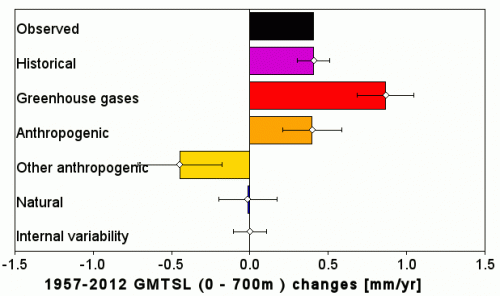Abstract's details
A new approach to detection and attribution of ocean thermal expansion
Event: 2015 Ocean Surface Topography Science Team Meeting
Session: Science III: Large scale and global change ocean processes: the ocean's role in climate
Presentation type: Oral
Tide gauges and satellite-based radar altimeter measurements provide evidence that the global mean sea level (GMSL) has been rising during the last two centuries and that this rate has been accelerating since the early 1900's, reaching 2.0±0.3 mm/year over 1971-2010 and 3.2±0.4 mm/year over 1993-2012 (Church et al. 2013). Ocean thermal expansion was identified as one of the main contributors, accounting for about 40% of the GMSL rise over 1971-2010 and 30% over 1993-2012 (Church et al. 2013).
However, the influence of natural and anthropogenic external forcings and of internal variability on the climate system and more specifically on the global mean thermosteric sea level (GMTSL) remains unclear while its understanding is essential to project sea level rise. This study aims at assessing the contributions of each forcing to the GMTSL changes, using a new detection and attribution method, based on additive decomposition. Developed by Ribes et al. (2015), this new approach dismisses the usual linear regression and proposes a symmetric treatment of the magnitude and pattern of the climate response to each forcing.
Idealized simulations of the climate system, with none or a chosen combination of forcings, provide some information on the pattern and amplitude of the GMTSL response to each forcing. We use a large ensemble of forced and unforced simulations issued from CMIP5 to calculate a first estimate of the GMTSL response to natural, anthropogenic, greenhouse gas and other forcings. Observational datasets are then used to constrain this first estimate to a more accurate result. Uncertainties may be further reduced by applying this statistical analysis to a bivariate case, i.e. to the responses over two different periods and/or regions.
First results on the layer 0 to 700 m deep from 1957 to 2012 (see figure) show that the observed GMTSL trend cannot be explained by climate internal variability and natural forcing only, nor by greenhouse gas emissions or other anthropic activity (including anthropic aerosols and ozone emissions, changes in land use). The response to the combination of all anthropogenic forcings gives a trend closer to observations, and, as expected, the response to all forcings (historical simulations) explains most of the observed trend. Investigation of more periods, regions and layers of the ocean, using bivariate analysis, will allow a more accurate quantification of each forcing contribution to observed GMTSL changes.

However, the influence of natural and anthropogenic external forcings and of internal variability on the climate system and more specifically on the global mean thermosteric sea level (GMTSL) remains unclear while its understanding is essential to project sea level rise. This study aims at assessing the contributions of each forcing to the GMTSL changes, using a new detection and attribution method, based on additive decomposition. Developed by Ribes et al. (2015), this new approach dismisses the usual linear regression and proposes a symmetric treatment of the magnitude and pattern of the climate response to each forcing.
Idealized simulations of the climate system, with none or a chosen combination of forcings, provide some information on the pattern and amplitude of the GMTSL response to each forcing. We use a large ensemble of forced and unforced simulations issued from CMIP5 to calculate a first estimate of the GMTSL response to natural, anthropogenic, greenhouse gas and other forcings. Observational datasets are then used to constrain this first estimate to a more accurate result. Uncertainties may be further reduced by applying this statistical analysis to a bivariate case, i.e. to the responses over two different periods and/or regions.
First results on the layer 0 to 700 m deep from 1957 to 2012 (see figure) show that the observed GMTSL trend cannot be explained by climate internal variability and natural forcing only, nor by greenhouse gas emissions or other anthropic activity (including anthropic aerosols and ozone emissions, changes in land use). The response to the combination of all anthropogenic forcings gives a trend closer to observations, and, as expected, the response to all forcings (historical simulations) explains most of the observed trend. Investigation of more periods, regions and layers of the ocean, using bivariate analysis, will allow a more accurate quantification of each forcing contribution to observed GMTSL changes.
Contribution: SC3-04-CHARLES.pdf (pdf, 9710 ko)
Back to the list of abstract